
Leroy Golf Egyptian Antiquities
With a couple of exceptions, such as the cylinder seal and amulet-seal immediately
below, the Egyptian material seems less well chosen and representative of its
culture than does the Sumerian or Syrian. Almost all the objects are large,
flashy, late dynastic or Ptolemaic items. A collector who purchased most of
them feels they have proper patina and are all genuine, but at least one noted
American dealer found that the ushabti and many amulets also closely match well
known tourist types sold by Middle Eastern “antique” dealers. I
have personally examined only three or four of Golf’s Egyptian items,
but found those to be proper and genuine, but I tend to agree with the dealer
who voiced suspicions about the ushabti and amulets. Egyptian material has been
faked for over a century and almost all Egyprtian items in commerce are at best
not what they claim to be.
It should be noted that Golf was in the oil business, and Egypt was not an
oil producing area then as were Northern and Southern Irak. It is therefore
less surprising that Golf’s Egyptian items lack breadth of scope and depth
of quality, and the fact that many of the items show a Canaanite or Syrian flavor
may indicate acquisition from Syria-Palestine rather than Egypt itself. Even
the wonderful cylinder seal of office (G-Egy 1) comes from the border Nome up
against Canaan. The eastern delta was an early source of many early Egyptian
antiquities in commerce, and a large part of Newberry’s examples came
from that location.
G-Egy 1: Steatite Cylinder Seal of a Nomarch of Amememhat III
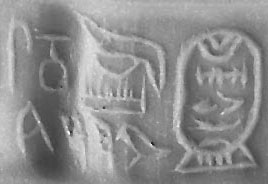 A
very nice and scarce official Egyptian cylinder seal. It bears the cartouche
of the Pharaoh Ahmenemhat III, c. 1850-1800 B.C., the last of the great rulers
of the 12th Dynasty. The inscription reads: “Beloved of Sobeck, Lord of
(Ha)Benu”. This makes it the official seal of the Nomarch of the 14th
Nome of Lower Egypt. The Habenu Nome was in the far northeast of Egypt at the
edge of Sinai, where the Horus Road to Asia began. This was the main land connection
for both trade and immigration of workers. Supposedly Joseph and the other Jews
came through Habenu at this time to work in the land of Egypt, and this Nomarch
would have been the man to admit them. The immense building projects of Ahmenemhat
exceeded the labor supply of Egypt, and both increased trade and labor migration
was experienced throughout his reign.
A
very nice and scarce official Egyptian cylinder seal. It bears the cartouche
of the Pharaoh Ahmenemhat III, c. 1850-1800 B.C., the last of the great rulers
of the 12th Dynasty. The inscription reads: “Beloved of Sobeck, Lord of
(Ha)Benu”. This makes it the official seal of the Nomarch of the 14th
Nome of Lower Egypt. The Habenu Nome was in the far northeast of Egypt at the
edge of Sinai, where the Horus Road to Asia began. This was the main land connection
for both trade and immigration of workers. Supposedly Joseph and the other Jews
came through Habenu at this time to work in the land of Egypt, and this Nomarch
would have been the man to admit them. The immense building projects of Ahmenemhat
exceeded the labor supply of Egypt, and both increased trade and labor migration
was experienced throughout his reign.
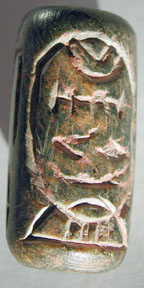
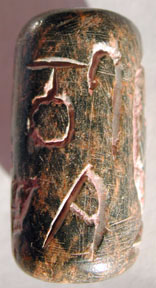 It
is carved in black steatite that has hints of Western Asian style, much like
Ur III seals. Coming from the borderland Habenu Nome partly explains its style,
and the stone blank may even have originally been a Sumerian import. The carving
style indicates that it was possibly carved locally rather than supplied by
the Pharaoh, and likely late in Ahmenemhat’s reign when the Nomarchs were
once again growing more independant. After Ahmenemhat’s death two of his
children had short reigns, and then the dynasty collapsed, with the Hyksos invaders
later seizing Habenu and all of Lower Egypt for centuries. Newberry’s
Egyptian Scarabs shows several other cylinder seals of office for the
14th Nome under earlier pharaohs that read and look the same except for the
ruler’s cartouche, and one of them also shows the same bold Asian style
of cutting as this one, even in Newberry’s carefully re-drawn plates.
Following the 13th Dynasty cylinder seals were rapidly replaced in Egypt by
scarabs stamp seals.
It
is carved in black steatite that has hints of Western Asian style, much like
Ur III seals. Coming from the borderland Habenu Nome partly explains its style,
and the stone blank may even have originally been a Sumerian import. The carving
style indicates that it was possibly carved locally rather than supplied by
the Pharaoh, and likely late in Ahmenemhat’s reign when the Nomarchs were
once again growing more independant. After Ahmenemhat’s death two of his
children had short reigns, and then the dynasty collapsed, with the Hyksos invaders
later seizing Habenu and all of Lower Egypt for centuries. Newberry’s
Egyptian Scarabs shows several other cylinder seals of office for the
14th Nome under earlier pharaohs that read and look the same except for the
ruler’s cartouche, and one of them also shows the same bold Asian style
of cutting as this one, even in Newberry’s carefully re-drawn plates.
Following the 13th Dynasty cylinder seals were rapidly replaced in Egypt by
scarabs stamp seals.
The heavily worn ends are usually the result of surface-find seals
used by Arab women as ornamental beads. Many of the cylinder seals in commerce
come from such Bedouin necklaces.
G-Egy 2: Black Stone Figurine Amulet-Seal
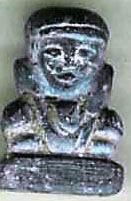
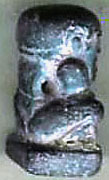
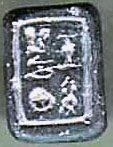 An
early New Kingdom period black stone amuletic seal that shows Phoenician influences.
The cursive nature of the inscription on the bottom and its coarse style may
show unfamiliarity with Egyptian hieroglyphics as well as a new Kingdom date.
The figure is likely Bes. In a private collection.
An
early New Kingdom period black stone amuletic seal that shows Phoenician influences.
The cursive nature of the inscription on the bottom and its coarse style may
show unfamiliarity with Egyptian hieroglyphics as well as a new Kingdom date.
The figure is likely Bes. In a private collection.
G-Egy 3: A Large, Late Dynastic or Ptolemaic Scarab
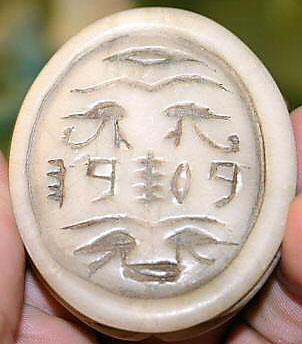 Most
scarabs are of a similar, c. 15 mm size except for the larger “Heart Scarabs”
which, due to their longer text, are several times larger than others. In the
late period large, amuletic scarabs appear of which this is one. It is of a
fine, translucent and highly polished steatite and has an inscription of the
bottom in a decorative style that hints at engraving an unfamiliar script. 60
mm x 48 mm x 18 mm. In a private collection.
Most
scarabs are of a similar, c. 15 mm size except for the larger “Heart Scarabs”
which, due to their longer text, are several times larger than others. In the
late period large, amuletic scarabs appear of which this is one. It is of a
fine, translucent and highly polished steatite and has an inscription of the
bottom in a decorative style that hints at engraving an unfamiliar script. 60
mm x 48 mm x 18 mm. In a private collection. 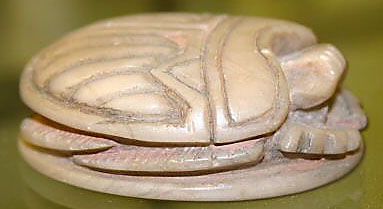
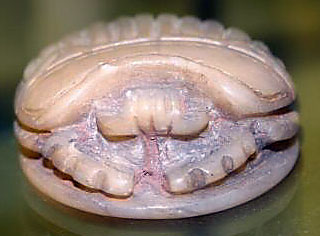
G-Egy 4: Glazed Pottery Ushabti
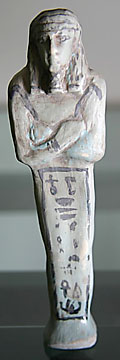 Turquoise
blue fading to white glazed ushabti with hieroglyphic inscription. c. 106 mm
tall. Location unknown.
Turquoise
blue fading to white glazed ushabti with hieroglyphic inscription. c. 106 mm
tall. Location unknown.
G-Egy 5: Glazed Pottery Ushabti
 Blue
fading to tan glazed ushabti c. 70 mm tall. Late dynastic period. Location
unknown.
Blue
fading to tan glazed ushabti c. 70 mm tall. Late dynastic period. Location
unknown.
G-Egy 6: Glazed Pottery Ushabti
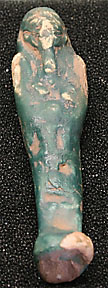 Deep
green glazed ushabti c. 70 mm tall, glaze mostly intact. Late dynastic period.
Location unknown.
Deep
green glazed ushabti c. 70 mm tall, glaze mostly intact. Late dynastic period.
Location unknown.
G-Egy 7: Glazed Pottery Ushabti
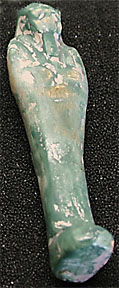 Medium
green glazed ushabti c. 70 mm tall. Late dynastic period. Location unknown.
Medium
green glazed ushabti c. 70 mm tall. Late dynastic period. Location unknown.
G-Egy 8: Glazed Pottery Ushabti
 Turquoise
blue fading to white glazed ushabti c. 70 mm tall. Glaze mostly surviving. Late
dynastic period. Location unknown.
Turquoise
blue fading to white glazed ushabti c. 70 mm tall. Glaze mostly surviving. Late
dynastic period. Location unknown.
G-Egy 9: Small Stone Ushabti
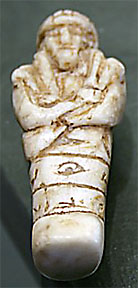
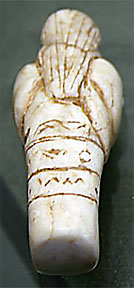 White
stone (alabaster?) ushabti c. 53 mm tall. Late dynastic period. Location
unknown.
White
stone (alabaster?) ushabti c. 53 mm tall. Late dynastic period. Location
unknown.
G-Egy 10: Winged Scarab Amulet
 Small
winged scarab in glazed pottery c. 50 mm wide. Late dynastic period. Location
unknown.
Small
winged scarab in glazed pottery c. 50 mm wide. Late dynastic period. Location
unknown.
G-Egy 11: Three-piece Winged Scarab Amulet
 A
three-piece winged scarab, likely a decorative applique. C. 137 mm wide with
attachment holes. Late dynastic period. Location unknown.
A
three-piece winged scarab, likely a decorative applique. C. 137 mm wide with
attachment holes. Late dynastic period. Location unknown.
G-Egy 12: Scarab
Scarab apx. 12 x 16 mm. Late dynastic period. Location unknown.
G-Egy 13: Scarab
Scarab apx. 12 x 16 mm. Late dynastic period. Location unknown.
G-Egy 14: Scarab
Scarab apx. 12 x 16 mm. Late dynastic period. Location unknown.
G-Egy 15: Scarab
Scarab apx. 16 x 20 mm. Late dynastic period. Location unknown.
G-Egy 16: Scarab
Scarab apx. 16 x 20 mm. Late dynastic period. Location unknown.
G-Egy 17: Scarab
Scarab apx. 16 x 20 mm. Late dynastic period. Location unknown.
G-Egy 18: Scarab
Scarab apx. 18 x 22 mm. Late dynastic period. Location unknown.
G-Egy 19: Scarab
Scarab apx. 18 x 22 mm. Late dynastic period. Location unknown.
G-Egy 20: Scarab
Scarab apx. 18 x 22 mm. Late dynastic period. Location unknown.
G-Egy 21: Lamp
Glazed pottery lamp apx. 97 x 59 36 mm. Late dynastic period. Location unknown.
G-Egy 22: Lamp
Glazed pottery lamp apx. 81 x 52 27 mm. Late dynastic period. Location unknown.
G-Egy 23: Amulet of Tawaret
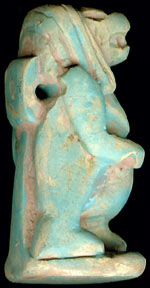 Stone
statue apx. 50 mm tall. Late dynastic period. Location unknown.
Stone
statue apx. 50 mm tall. Late dynastic period. Location unknown.
G-Egy 24: Statuette of Thoth
Stone statue apx. 85 mm tall. Late dynastic period. Location unknown.
G-Egy 25: Lotus Amulet
Stone amulet of a lotus bud apx. 40 mm tall. Late dynastic period. Location
unknown.
G-Egy 26: Double Scroll Amulet
Stone amulet of a double papyrus scroll in color apx. 50 mm wide. Late dynastic
period. Location unknown.
G-Egy 27: Red Stone Fish Amulet
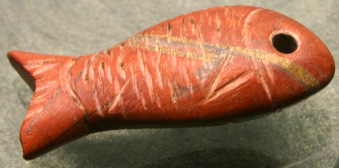 A red
(jasper?) stone amulet of a fish apx. 50 mm tall. New Kingdon to Late Dynastic
period. Location unknown.
A red
(jasper?) stone amulet of a fish apx. 50 mm tall. New Kingdon to Late Dynastic
period. Location unknown.
G-Egy 28: Eye Amulet
An eye amulet apx. 55 mm wide. Late dynastic period. Location unknown.
G-Egy 29: Amulet
Glazed amulet. Late dynastic period. Location unknown.
G-Egy 30: Duck-shaped Stone Weight
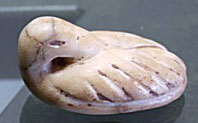
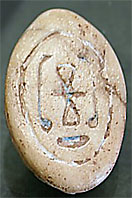 A
small duck-shaped stone weight with the head turned back. Inscription on the
bottom. Duck shaped weights are found around the ancient world from Sumeria
to Egypt. This one is c. 40 mm long. New Kingdom to Late Dynastic period. Location
unknown.
A
small duck-shaped stone weight with the head turned back. Inscription on the
bottom. Duck shaped weights are found around the ancient world from Sumeria
to Egypt. This one is c. 40 mm long. New Kingdom to Late Dynastic period. Location
unknown.
G-Egy 31:Glazed Amulet
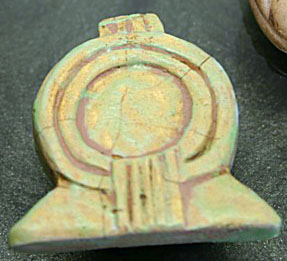 Glazed
blue amulet fading to tan. Location unknown.
Glazed
blue amulet fading to tan. Location unknown.
G-Egy 32: Glazed Crowned Head Amulet
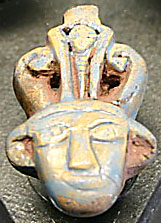 A
large-eared face with a three part crown in blue glazed pottery. Apx. 40 mm
tall. Location unknown.
A
large-eared face with a three part crown in blue glazed pottery. Apx. 40 mm
tall. Location unknown.
G-Egy 33: Glazed Amulet
A small glazed amulet apx. 22 mm wide. Location unknown.
G-Egy 34: Glazed Amulet
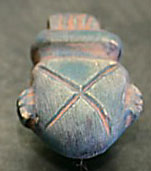 A
small blue-glazed pottery amulet of a pot or container (?) apx. 22 mm tall.
Location unknown.
A
small blue-glazed pottery amulet of a pot or container (?) apx. 22 mm tall.
Location unknown.
G-Egy 35: Sun Boat Amulet
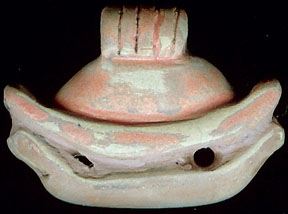 A
solar sun boat amulet in blue glazed pottery, fading to tan. Size unknown. Location
unknown.
A
solar sun boat amulet in blue glazed pottery, fading to tan. Size unknown. Location
unknown.
G-Egy 36: Date Palm Amulet
 Green
glazed pottery date palm amulet apx. 52 mm tall. Late dynastic period. Location
unknown.
Green
glazed pottery date palm amulet apx. 52 mm tall. Late dynastic period. Location
unknown.
Leroy Golf Collection Home
Antiques AtoZ Home

 A
very nice and scarce official Egyptian cylinder seal. It bears the cartouche
of the Pharaoh Ahmenemhat III, c. 1850-1800 B.C., the last of the great rulers
of the 12th Dynasty. The inscription reads: “Beloved of Sobeck, Lord of
(Ha)Benu”. This makes it the official seal of the Nomarch of the 14th
Nome of Lower Egypt. The Habenu Nome was in the far northeast of Egypt at the
edge of Sinai, where the Horus Road to Asia began. This was the main land connection
for both trade and immigration of workers. Supposedly Joseph and the other Jews
came through Habenu at this time to work in the land of Egypt, and this Nomarch
would have been the man to admit them. The immense building projects of Ahmenemhat
exceeded the labor supply of Egypt, and both increased trade and labor migration
was experienced throughout his reign.
A
very nice and scarce official Egyptian cylinder seal. It bears the cartouche
of the Pharaoh Ahmenemhat III, c. 1850-1800 B.C., the last of the great rulers
of the 12th Dynasty. The inscription reads: “Beloved of Sobeck, Lord of
(Ha)Benu”. This makes it the official seal of the Nomarch of the 14th
Nome of Lower Egypt. The Habenu Nome was in the far northeast of Egypt at the
edge of Sinai, where the Horus Road to Asia began. This was the main land connection
for both trade and immigration of workers. Supposedly Joseph and the other Jews
came through Habenu at this time to work in the land of Egypt, and this Nomarch
would have been the man to admit them. The immense building projects of Ahmenemhat
exceeded the labor supply of Egypt, and both increased trade and labor migration
was experienced throughout his reign.

 It
is carved in black steatite that has hints of Western Asian style, much like
Ur III seals. Coming from the borderland Habenu Nome partly explains its style,
and the stone blank may even have originally been a Sumerian import. The carving
style indicates that it was possibly carved locally rather than supplied by
the Pharaoh, and likely late in Ahmenemhat’s reign when the Nomarchs were
once again growing more independant. After Ahmenemhat’s death two of his
children had short reigns, and then the dynasty collapsed, with the Hyksos invaders
later seizing Habenu and all of Lower Egypt for centuries. Newberry’s
Egyptian Scarabs shows several other cylinder seals of office for the
14th Nome under earlier pharaohs that read and look the same except for the
ruler’s cartouche, and one of them also shows the same bold Asian style
of cutting as this one, even in Newberry’s carefully re-drawn plates.
Following the 13th Dynasty cylinder seals were rapidly replaced in Egypt by
scarabs stamp seals.
It
is carved in black steatite that has hints of Western Asian style, much like
Ur III seals. Coming from the borderland Habenu Nome partly explains its style,
and the stone blank may even have originally been a Sumerian import. The carving
style indicates that it was possibly carved locally rather than supplied by
the Pharaoh, and likely late in Ahmenemhat’s reign when the Nomarchs were
once again growing more independant. After Ahmenemhat’s death two of his
children had short reigns, and then the dynasty collapsed, with the Hyksos invaders
later seizing Habenu and all of Lower Egypt for centuries. Newberry’s
Egyptian Scarabs shows several other cylinder seals of office for the
14th Nome under earlier pharaohs that read and look the same except for the
ruler’s cartouche, and one of them also shows the same bold Asian style
of cutting as this one, even in Newberry’s carefully re-drawn plates.
Following the 13th Dynasty cylinder seals were rapidly replaced in Egypt by
scarabs stamp seals. 

 An
early New Kingdom period black stone amuletic seal that shows Phoenician influences.
The cursive nature of the inscription on the bottom and its coarse style may
show unfamiliarity with Egyptian hieroglyphics as well as a new Kingdom date.
The figure is likely Bes. In a private collection.
An
early New Kingdom period black stone amuletic seal that shows Phoenician influences.
The cursive nature of the inscription on the bottom and its coarse style may
show unfamiliarity with Egyptian hieroglyphics as well as a new Kingdom date.
The figure is likely Bes. In a private collection. Most
scarabs are of a similar, c. 15 mm size except for the larger “Heart Scarabs”
which, due to their longer text, are several times larger than others. In the
late period large, amuletic scarabs appear of which this is one. It is of a
fine, translucent and highly polished steatite and has an inscription of the
bottom in a decorative style that hints at engraving an unfamiliar script. 60
mm x 48 mm x 18 mm. In a private collection.
Most
scarabs are of a similar, c. 15 mm size except for the larger “Heart Scarabs”
which, due to their longer text, are several times larger than others. In the
late period large, amuletic scarabs appear of which this is one. It is of a
fine, translucent and highly polished steatite and has an inscription of the
bottom in a decorative style that hints at engraving an unfamiliar script. 60
mm x 48 mm x 18 mm. In a private collection. 

 Turquoise
blue fading to white glazed ushabti with hieroglyphic inscription. c. 106 mm
tall. Location unknown.
Turquoise
blue fading to white glazed ushabti with hieroglyphic inscription. c. 106 mm
tall. Location unknown. Blue
fading to tan glazed ushabti c. 70 mm tall. Late dynastic period. Location
unknown.
Blue
fading to tan glazed ushabti c. 70 mm tall. Late dynastic period. Location
unknown. Deep
green glazed ushabti c. 70 mm tall, glaze mostly intact. Late dynastic period.
Location unknown.
Deep
green glazed ushabti c. 70 mm tall, glaze mostly intact. Late dynastic period.
Location unknown.  Medium
green glazed ushabti c. 70 mm tall. Late dynastic period. Location unknown.
Medium
green glazed ushabti c. 70 mm tall. Late dynastic period. Location unknown. Turquoise
blue fading to white glazed ushabti c. 70 mm tall. Glaze mostly surviving. Late
dynastic period. Location unknown.
Turquoise
blue fading to white glazed ushabti c. 70 mm tall. Glaze mostly surviving. Late
dynastic period. Location unknown.
 White
stone (alabaster?) ushabti c. 53 mm tall. Late dynastic period. Location
unknown.
White
stone (alabaster?) ushabti c. 53 mm tall. Late dynastic period. Location
unknown. Small
winged scarab in glazed pottery c. 50 mm wide. Late dynastic period. Location
unknown.
Small
winged scarab in glazed pottery c. 50 mm wide. Late dynastic period. Location
unknown. A
three-piece winged scarab, likely a decorative applique. C. 137 mm wide with
attachment holes. Late dynastic period. Location unknown.
A
three-piece winged scarab, likely a decorative applique. C. 137 mm wide with
attachment holes. Late dynastic period. Location unknown. Stone
statue apx. 50 mm tall. Late dynastic period. Location unknown.
Stone
statue apx. 50 mm tall. Late dynastic period. Location unknown. A red
(jasper?) stone amulet of a fish apx. 50 mm tall. New Kingdon to Late Dynastic
period. Location unknown.
A red
(jasper?) stone amulet of a fish apx. 50 mm tall. New Kingdon to Late Dynastic
period. Location unknown.
 A
small duck-shaped stone weight with the head turned back. Inscription on the
bottom. Duck shaped weights are found around the ancient world from Sumeria
to Egypt. This one is c. 40 mm long. New Kingdom to Late Dynastic period. Location
unknown.
A
small duck-shaped stone weight with the head turned back. Inscription on the
bottom. Duck shaped weights are found around the ancient world from Sumeria
to Egypt. This one is c. 40 mm long. New Kingdom to Late Dynastic period. Location
unknown. Glazed
blue amulet fading to tan. Location unknown.
Glazed
blue amulet fading to tan. Location unknown. A
large-eared face with a three part crown in blue glazed pottery. Apx. 40 mm
tall. Location unknown.
A
large-eared face with a three part crown in blue glazed pottery. Apx. 40 mm
tall. Location unknown. A
small blue-glazed pottery amulet of a pot or container (?) apx. 22 mm tall.
Location unknown.
A
small blue-glazed pottery amulet of a pot or container (?) apx. 22 mm tall.
Location unknown. A
solar sun boat amulet in blue glazed pottery, fading to tan. Size unknown. Location
unknown.
A
solar sun boat amulet in blue glazed pottery, fading to tan. Size unknown. Location
unknown.  Green
glazed pottery date palm amulet apx. 52 mm tall. Late dynastic period. Location
unknown.
Green
glazed pottery date palm amulet apx. 52 mm tall. Late dynastic period. Location
unknown.